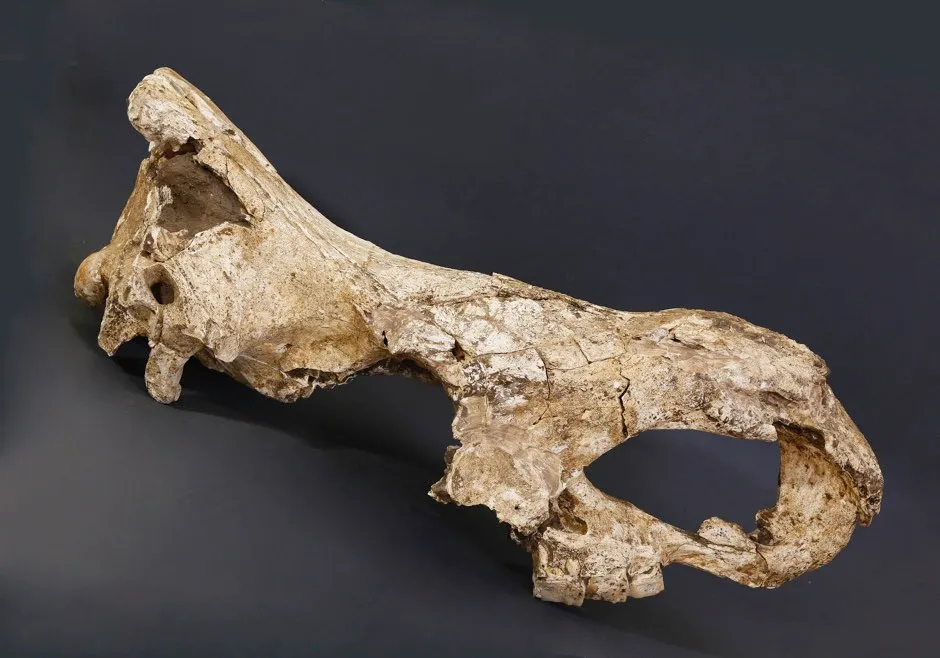The oldest genetic data ever to be recorded has been extracted from a 1.7 million-year-old rhino tooth.Scientists said the feat sparks an evolution revolution that could solve some of the biggest mysteries of animal and human biology.
Researchers identified an almost complete set of proteins, a proteome, in the dental enamel of the rhino.The genetic information discovered is one million years older than the oldest DNA sequenced, which came from a 700,000-year-old horse.
Read more about prehistoric animals:
- Who are the hunters of rare mammoth tusks in Russia?
- Oldest-ever liquid blood found in 42,000-year-old ice age horse
The findings by scientists from the University of Copenhagen and St John’s College, University of Cambridge, are published in the Nature journal.They said the breakthrough in the field of ancient biomolecular studies will allow researchers to accurately reconstruct evolution from further back in time than ever before.
First author Professor Enrico Cappellini, a specialist in palaeoproteomics at the Globe Institute, University of Copenhagen, said: “For 20 years, ancient DNA has been used to address questions about the evolution of extinct species, adaptation and human migration but it has limitations.
“Now, for the first time, we have retrieved ancient genetic information which allows us to reconstruct molecular evolution way beyond the usual time limit of DNA preservation. This new analysis of ancient proteins from dental enamel will start an exciting new chapter in the study of molecular evolution.”

Human evolution that is tracked by DNA only covers the last 400,000 years.But the lineages that led to modern humans and to the chimp branched apart around six to seven million years ago.This means scientists currently have no genetic information for more than 90% of the evolutionary path that led to modern humans.
They also do not know what the genetic links are between us and extinct species such as Homo erectus – the oldest known species of human to have had modern human-like body proportions.As things stand, everything that is known is based almost exclusively on anatomical and not genetic information.
But researchers have now used ancient protein sequencing – based on groundbreaking technology called mass spectrometry – to retrieve genetic information from the tooth of a 1.77 million-year-old Stephanorhinus – an extinct rhinoceros which lived in Eurasia during the Pleistocene.
Read more about DNA:
- Stone Age chewing gum reveals history of Scandinavia
- Environmental DNA and the hunt for marine species
They took samples of dental enamel from the ancient fossil, which was discovered in Dmanisi, Georgia.Mass spectrometry was used to sequence the ancient protein and retrieved genetic information previously unobtainable using DNA testing.
Tooth enamel is the hardest material present in mammals, and the set of proteins it contains lasts longer than DNA and is more genetically informative than collagen, scientists said.
Professor Jesper Olsen, at the Novo Nordisk Foundation Centre for Protein Research, University of Copenhagen, said: “Mass spectrometry-based protein sequencing will enable us to retrieve reliable and rich genetic information from mammal fossils that are millions of years old, rather than just thousands of years old.
“It is the only technology able to provide the robustness and accuracy needed to sequence tiny amounts of protein this old.”
Lead author on the paper Professor Eske Willerslev, who holds positions at St John’s College, University of Cambridge, said: “This research is a game-changer that opens up a lot of options for further evolutionary study in terms of humans as well as mammals.
“It will revolutionise the methods of investigating evolution based on molecular markers and it will open a complete new field of ancient biomolecular studies.”
